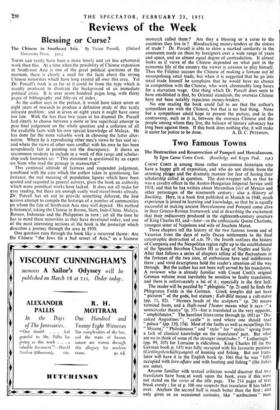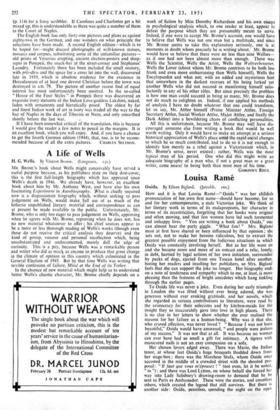Two Famous Towns
The Destruction and Resurrection of Pompeii and Herculaneum. By Egon Caesar Conte Corti. (Routledge and Kegan Paul. 25s.)
Counrr Court is among those rather uncommon historians who have a happy gift of exposition, and who do not shrink from the arresting phrase and the dramatic manner for fear of having their scholarship called In question. The dust-wrapper tells us that he was a cavalry officer in the Austro-Hungarian Imperial Service until 1918, and that he has written about Maxmilian (sic) of Mexico and other personages of the nineteenth century ; also a History of Smoking. Here, in a book first published in Munich in 1940, much experience is joined to learning and knowledge, so that he is equally successful at making ancient Herculaneum and Pompeii come alive in their Graeco-Roman framework and at describing the excitement that their rediscovery produced in the eighteenth-century courtiers of King Charles III, and—later—in the enthusiastic Queen Charlotte, youngest sister of Napoleon and wife of Joachim Murat.
Three chapters tell the history of the two famous towns and at Vesuvius from the days of early Oscan settlements to the final catastrophic destruction of A.D. 79 ; the fourth outlines the history of Campania and the Neapolitan region right up to the establishment of the Spanish Bourbon Charles III as King of Naples and Sicily. After that follows a series of chapters telling of the fluctuations in the fortunes of the two sites, of enthusiasm here and indifference there ; and vivid descriptions hold the reader's attention all the way through. But the author has not been well served by his translators. A reviewer who is already familiar with Count Corti's original German volume must inevitably be sensitive to faulty translation, and there is unfortunately a lot of it ; especially in the first half.
The reader will be puzzled by " phlogistic " (p. 2) until he finds the Phlegraean Fields in the German. Greek temples did not have " pictures" of the gods, but statues ; Kult-Bild means a cult-statue (pp. 11, 82). " Hermes heads of the sculptors " (p. 28) means terminal busts, and a Halb-rand Theater means what it says—" a semicircular theatre" (p. 37)—but is translated as the very opposite, " amphitheatre." The barefoot friars come through (p. 101) as " Dis- calced Augustines" ; "castle " is used where one should read " palace " (pp. 110, 174). Most of the faults as well as mispellings like " Mycene," "Philodemous " and " stylo " for " stylus " spring from a lack of classical knowledge on the translators' part. But what are we to think of some of the stranger ineptitudes ? " Lotheringia " (pp. 99, 105) for Lorraine is ridiculous. King Charles III (in the German book p. 145) was fully occupied with his favourite pastimes (Lieblingsbeschiiftigungen) of hunting and fishing. But our trans- lator will have it in the English book (p. 106) that he was " ft111Y occupied with love-affairs and with hunting and fishing " (the italics are mine).
Anyone familiar with textual criticism would discover that two translators have been; at work upon the book, even if this were not stated on the verso of the title page. The 214 pages of text break evenly ; for at p. 108 one suspects that translator B has taken over. Anyhow the second half is much better than the first ; and only gives us an occasional curiosity, like " scribacious " man (p. 114) for a fussy scribbler. If Carolines and Charlottes get a bit mixed up, this is understandable as there was quite a number of them in the Court of Naples.
The English book has only forty-one pictures and plans as against eighty-two in the German, and one wonders on what principle the selections have been made. A second English edition—which is to be hoped for—might discard photographs of well-known statues, mosaics and corpses, substituting some of the unfamiliar pictures— old prints of Vesuvius erupting, ancient election-posters and shop- signs in Pompeii, the snack-bar at the street-corner and Stephanus' Laundry. Fortunately there has been included the small oratory, with prie-dieu and the space for a cross let into the wall, discovered late in 1939, which is absolute evidence for the existence in Herculaneum of at least one devout Christian before the town was destroyed in A.D. 79. The picture of another recent find of equal interest has most unfortunately been omitted. In the so-called " House of the Four Styles " in Pompeii there was discovered an exquisite ivory statuette of the Indian Lobe-goddess Lakshmi, naked, laden with ornaments and hieratically posed. The oldest by far and finest Indian work of art in ivory was traded all the way to the bay of Naples in the days of Tiberius or Nero, and only unearthed shortly before the last war.
If I have been somewhat critical of the translation, this is because I would give the reader a few notes to pencil in the margins. It is an excellent book, which you will enjoy. And, if you have a chance to get the fourth German edition (1944), that, too, is to be recom-
mended because of all the extra pictures. CHARLES SELTMAN.







































 Previous page
Previous page